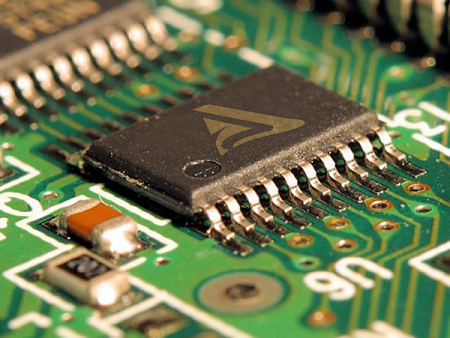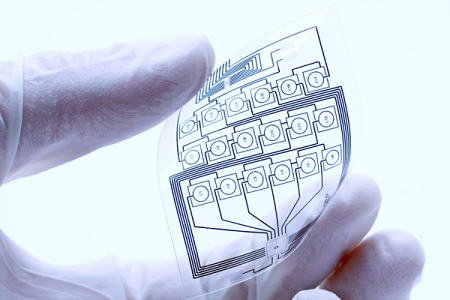
Introduction
A large automotive supplier decided that one additional clear-coat of paint was needed to really make their new touch-integrated center console system look great. Unfortunately, that thin coat of paint caused several of the touch-sensitive buttons to stop working. This resulted in a production stoppage and forced a redesign of the car's center console.
In a separate example, a large recreational vehicle (RV) uses a touch-integrated keyless entry system, which includes LED back-lighting. However, every time rain or other water splashes onto the buttons, the key-less system turns on, draining batteries and causing campers to frequently replace batteries, lose functionality, and risk getting locked out of their RVs. Elsewhere, thousands of phone calls and text messages are going unanswered as smartphone users try in vain to accept a call or type while wearing gloves.
These are just a few examples of the endless stories of products using electric-field-based capacitive touch technologies that fail to live up to the rigors of the real world. Innovative touch-control devices have gained popularity in the broad consumer marketplace and their users are beginning to expect great experiences regardless of the weather.
Touch Sucks
"Touch sucks" is how a former Apple engineering manager described capacitive touch systems. He spent years battling the technology to make it work seamlessly for consumers. These touch systems, like those used in the iPhone and other personal computing devices, sense capacitive changes in electric fields and use thresholds—a set amount of capacitive change—to trigger touch inputs.
While there are companies that make highly engineered end products look easy, the dark secret of the industry is that almost everything affects capacitance. This means engineers face a constant battle with variance. The slightest change, like a layer of paint, can impact how a touch panel feels or if a touch system works at all.
Additionally, environmental factors wreak havoc on these systems. Temperature changes, liquid splashes, or wearing gloves can trigger a touch or keep a touch from triggering. A unique vernacular has sprung from this with phrases like "false-trigger" or "butt-dial." These issues have given rise to new industries like gloves that will work with touch screens.
Variance And The Parasitics That Effect Touch
As the former CTO of TouchSensor Technologies and a 30-year veteran of the touch technology field, I can recount the infinite compromises and countless headaches battling touch. This includes the stacks of touch panels in the defective pile because of nameless variances that caused touch button failures.
Manufacturing variance cripples capacitive touch systems. Once a touch system is designed and configured and thresholds are set, capacitive changes can sneak in during the manufacturing process in the slightest ways. I have seen the humidity level of printed circuit boards affect the dielectric constant of batches of boards differently, causing a touch system to feel different from part to part or fail altogether.
Adhesives are another culprit. Adhering, potting, or optically bonding circuit boards is virtually never a perfectly uniform process, and changes in thickness, air gaps or bubbles can cause serious touch system challenges. Surface manipulation, such as grinding, milling, or painting, often yields variance.
Noise also rains havoc upon capacitive touch systems. The term noise can be use broadly to refer to any type of interference. Perhaps the two most common types are injected line noise, such a power surges from an outside source, and radiative noise, such as radio-interference.
Noise interferences like these, which can pulse at more than 500 million cycles-per-second, create huge swings in capacitance that can cause a threshold-based capacitive system to false trigger. Temperature change is another source of capacitive noise, but these changes typically happen much, much slower.
Essentially, the real world is an expensive threat to capacitive touch systems. When it's cold, people wear gloves, and unless they are specially made, gloves have a hard time creating enough capacitance to trigger a touch threshold. Water creates a capacitive change that can appear very similar to a finger. Splashes of water, rain or moisture can create functionality problems for threshold-based capacitive systems. Screen protectors can change where a touch occurs in relationship to the surface, which can make a touch feel different. Contamination, especially conductive things like salt films, can limit or disable touch systems.
Remove Thresholds, Defeat Variance, And Unlock The Potential Of Electric-Field Touch
There are countermeasures that can be applied to overcome the limitations of thresholds. There are ways to build dynamically changing baselines, switching between self and mutual modes, over processing, etc. But these countermeasures always tend to lead to compromises that manage trade-offs between costs, noise sensitivity, response time, water immunity, power consumption, and functionality.
Touch signatures unlock a level of robustness that changes the game. Removing thresholds from touch sensing truly does unlock the potential of the electric field, thereby increasing manufacturing yield rates, improving noise performance, and boosting touch performance.
While we can't change the physics of electric fields, we can change how we capture and use information from the electric field. With enough of the right information, we can determine an actual touch event at the real touch surface rather than an arbitrary trigger point, without using thresholds and we can do it in a way that distinguishes it from the variance that causes capacitive thresholds to false trigger. We call this collective information a "Touch Signature."
For example, while both might create enough capacitive change to trigger a threshold, the signature of water hitting a surface is different than the signature of a finger touching the surface, unlocking a new level of water-immune performance. Touch signatures remain consistent, even if there is manufacturing variance that would make a touch event feel differently if it were driven by an arbitrary threshold.
As one example, AlSentis HSS touch-recognition technology uses touch signatures instead of capacitive thresholds to sense actual touch events. The technology is in the marketplace today, proving itself in some highly difficult applications.

AlSentis HSS touch-recognition control chip
One example is in HSS replacing a leading microcontroller company that developed a solution for a customer that wanted touch buttons behind a thick piece of glass (3.5+ mm), using tiny electrodes the size of a pinky finger, with holes cut in them for LED back-lighting on a polyimide flexible circuit. In their system, capacitive thresholds could be used to make the part work in the laboratory for a single demonstration part, but with the same configuration in the end product, the subsequent parts failed. Having a unique design for every touch part that came off the production line was hardly reasonable, so the program was in jeopardy.

HSS touch-screen material
Using HSS technology, the end customer was able to make the solution work reliably with a single configuration: remove the optical adhesive and mechanically press the flex to the glass, creating an environment with enormous variance from part to part. Yet, every part worked and the touch always felt exactly the same. Nearly half a million automotive-compliant parts have shipped with zero defects (0 ppm).
The implications of removing thresholds from sensing systems are huge. A touch signature not only provides a touch experience that always feels the same while ignoring variance, but the signature itself can be customizable. If a user had a reason to only allow a slow or a fast touch, it could be built directly into the signature.
Signatures can be tailored to take into account specific movements that qualify or disqualify a touch event. Signatures can be used to define proxy events that ignore noise. Signatures can be integrated into user-feedback tools such as haptic drivers that trigger instantly when a finger touches a surface, creating a perfectly consistent haptic response regardless of system variance.
Customized signatures can drive unique feedbacks, be they haptic, light, or sound, thus opening up new options for human machine interface. While AlSentis is focusing on commercializing product first in electric field, the same core HSS technology can be applied to virtually any field that can be sensed to capture enough information to overcome variance.
Conclusion
Moving away from a reliance on touch thresholds is fundamental to improving manufacturing yields, increasing product reliability, and reducing recalls, failures, and frustrations. HSS touch-recognition technology uses touch signatures to not only create dependable touch performance, but also to unlock new features that would be impractical in threshold-driven touch systems.
About the Author
Dave Caldwell is the former co-founder and CTO of TouchSensor Technologies, LLC, now owned by Methode Electronics, Inc. He has more than 30 technology patent filings over his three decades in electronics and sensors, and has developed three fundamentally unique touch technologies in his career. He is a veteran of the US Navy, having served in the Nuclear Propulsion program.
Related Stories
Atmel Introduces Touch Sensing Technology To Revolutionize Industrial Designs
Smart Coatings Market Set to Reach $ 5.8 Billion by 2020
Synaptics Pushes the Boundaries of Human Interface
Touchless Sensing Technology Represents the Next Paradigm in Human-Machine Interface